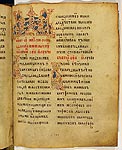Gospel Complete Aprakos.
1362. Novgorod. Scribe: Mikula
F (277 ı 220). 253 leaves. Several leaves are missing from the middle part of the book.
Parchment. Ink, cinnabar, colours.
It is written in a uncial hand in two columns.
The decoration of the manuscript includes teratological head-pieces in colours (fols. 2ra, 78ra, 100ra) and initials, containing human figures (fols. 97v, 99r, 100r, 112v, 139v).
Folios 253v bears the scribe's inscription that says that the book was created in 1362 in Veliky Novgorod (Novgorod the Great) by order of Archbishop of Novgorod Alexej during the reign of Prince Dmitri Konstantinivich.
The manuscript was produced in Novgorod that was one of the largest centers for Russian and Slavonic literature during the 14th century. The book arts were especially flourishing in the times of Archbishops Moses and Alexej who comissioned the manuscript. Mix of the local ornamental tradition - the teratological pattern - and miniatures, inspired by the Byzantine tradition, leaves a particular mark on Novgorod manuscripts. Reseachers note that the Novgorod teratological design is unparalleled in artistry of its craftsmanship in Russia. In spite of canonical techniques and means of graphic representation, each head-piece and letter from the Gospel reflects the individuality of the artist. Any initial from the book may be regarded as an original work of art. Letters and head-pieces are simple and, at the same time, masterful in drawing and composition. They are very colourful and captivating by their vivid and steady rhythm.
In 1919 the manuscript came into the State Public Library along with the collection of St Sophia's Cathedral in Novgorod.
Shelfmark: –Õ¡. —ÓÙ. 3.





